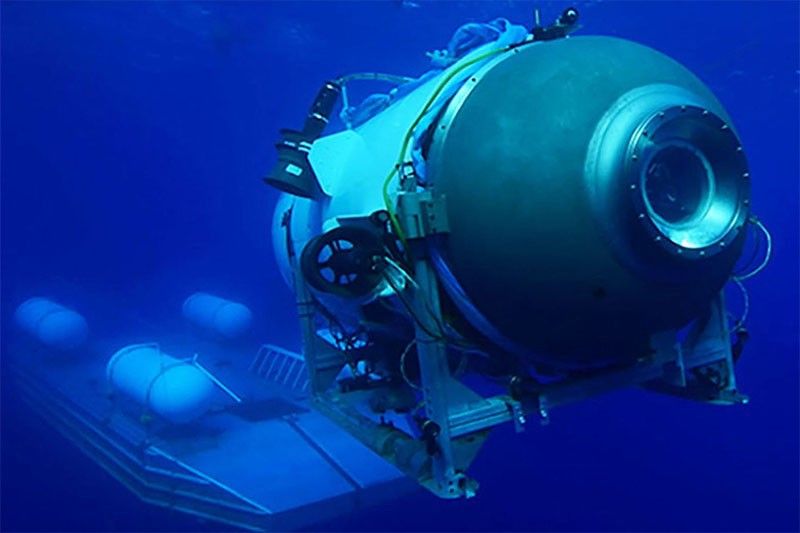Boeing, University of Washington deny involvement in missing Titan submersible’s design
This undated image courtesy of OceanGate Expeditions, shows their Titan submersible launching from a platform. Rescue teams expanded their search underwater on June 20, 2023, as they raced against time to find a Titan deep-diving tourist submersible that went missing near the wreck of the Titanic with five people on board and limited oxygen. All […]


This undated image courtesy of OceanGate Expeditions, shows their Titan submersible launching from a platform. Rescue teams expanded their search underwater on June 20, 2023, as they raced against time to find a Titan deep-diving tourist submersible that went missing near the wreck of the Titanic with five people on board and limited oxygen. All communication was lost with the 21-foot (6.5-meter) Titan craft during a descent June 18 to the Titanic, which sits at a depth of crushing pressure more than two miles (nearly four kilometers) below the surface of the North Atlantic.
AFP / Handout / OceanGate Expeditions
MANILA, Philippines — Aircraft company Boeing and the University of Washington (UW) have separately denied being involved in the design of the missing Titan submersible, despite OceanGate Expeditions’ claims in the past that both had collaborated on its creation.
Five people are known to be aboard the Titan: OceanGate head Stockton Rush, French submarine operator Paul-Henri Nargeolet, British billionaire Hamish Harding, Pakistani tycoon Shahzada Dawood and his son Suleman.
The Titan is meant to ferry passengers down to the remains of the Titanic — which sank during its 1912 maiden voyage after hitting an iceberg — almost four kilometers below the surface of the North Atlantic. Reports said a total of 2,224 passengers and crew were on board the Titanic, and more than 1,500 people died.
OceanGate’s website states that the Titan was a collaborative design of the two aforementioned entities along with the National Aeronautics and Space Administration.
However, both UW and Boeing separately told CNN they had no involvement in the Titan’s creation.
“Boeing was not a partner on the Titan and did not design or build it,” a spokesperson for the aircraft company said.
The executive director of UW’s Applied Physics Laboratory Kevin Williams said it was “not involved in the design, engineering or testing of the TITAN submersible used in the RMS TITANIC expedition.”
Related: Submersible exploring Titanic wreck missing over 24 hours
Williams’ statement was backed by fellow UW colleague Victor Balta, who said that while the university signed an agreement with OceanGate, it did not see it through.
Design and safety criticism
Since the disappearance of the Titan, discussions about the subermersible’s design were criticized beyond the 22-foot-long and 9-foot-wide measurements.
The Titan is made from carbon-fiber, a questionable material since the submersible is expected to dive to extreme depths.
The submersible is steered using a gaming-like controller, has no GPS system, and relies on text messages sent via an acoustic system for guidance from a ship on the surface — often the one that launches and recovers it.
On the safety front, passengers on the Titan cannot exit without external assistance as they are sealed inside the main cabin by bolts removable only from the outside.
Related: Rescuers boost efforts as clock ticks to find lost Titanic sub
Such safety issues are compounded by revelations that the submersible has no proper regulation. Passengers must sign a contract acknowledging the Titan is an experimental vessel; the same contract also states the £200,000 (P14.2 million) trips “could result in physical injury, disability, emotional trauma, or death.”
‘Cold’ and ‘horrible’
Former passenger Aaron Newman told NBC’s Today that if the Titan had no power and was several hundred meters deep, passengers would be freezing in complete darkness.
“It was cold when we were at the bottom. You had layered up. You had wool hats on and were doing everything to stay warm at the bottom,” Newman said.
Meanwhile, Syracuse University professor emeritus of earth and environmental sciences Jeff Karson said the temperature is just above freezing and the Titan is too deep to be retrieved by divers, meaning the best chances lie in a remotely operated robot on a fiber optic cable.
“I am sure it is horrible down there,” Karson said. “It is like being in a snow cave and hypothermia is a real danger.”
RELATED: Search for missing Titanic sub like ‘going into space’











